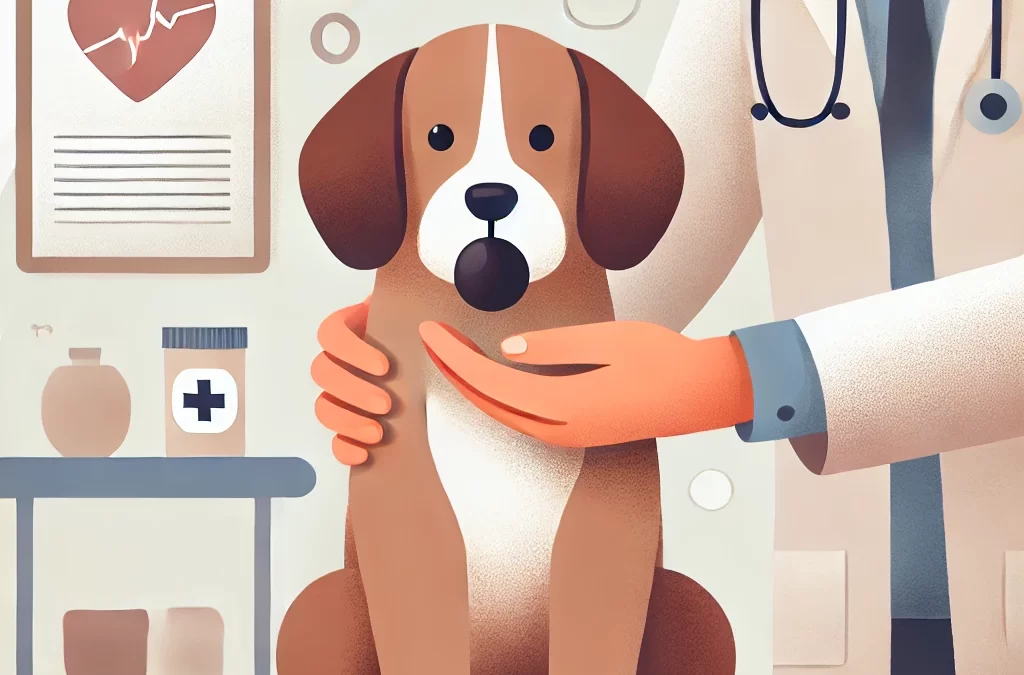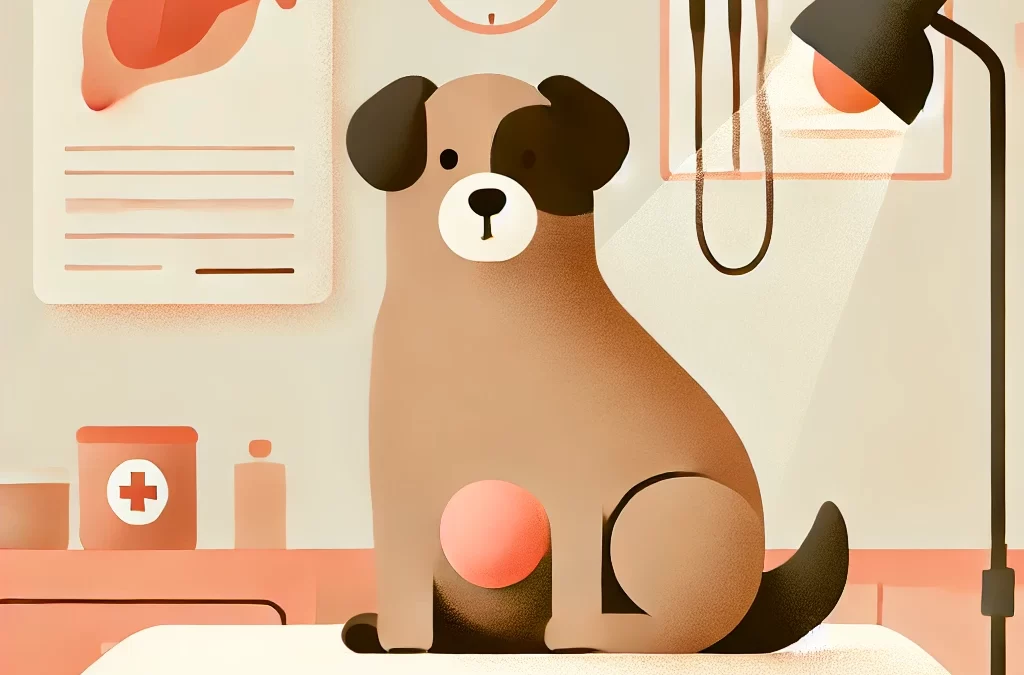
por TCMVET | 20 de diciembre de 2024 | Cáncer y tumores en perros
El cáncer en perros ha sido un tema de preocupación para los dueños de mascotas durante mucho tiempo. Si bien es natural sentirse abrumado cuando se enfrenta a este diagnóstico, comprender las causas puede ofrecer información sobre la prevención y el tratamiento. Este artículo profundiza en las posibles razones detrás del cáncer en perros, arrojando luz sobre factores genéticos, ambientales y de estilo de vida.
Predisposición genética: un factor silencioso
Una de las principales razones por las que los perros desarrollan cáncer es la genética. Algunas razas son más propensas a padecerlo debido a rasgos hereditarios. Por ejemplo, se sabe que los golden retriever, los bóxers y los rottweilers tienen una mayor probabilidad de desarrollar cánceres como el linfoma y el osteosarcoma. Esta predisposición genética resalta la importancia de las prácticas de crianza responsables para minimizar el riesgo.
Toxinas ambientales: amenazas invisibles
Los perros suelen estar expuestos a toxinas ambientales sin que sus dueños se den cuenta. Los pesticidas, los herbicidas, el humo de segunda mano e incluso los productos de limpieza del hogar pueden contribuir al desarrollo del cáncer. La exposición prolongada a estas sustancias nocivas puede desencadenar mutaciones en las células, lo que a la larga conduce al crecimiento de tumores.
Dieta y obesidad: alimentando el riesgo
Una dieta deficiente, carente de nutrientes esenciales o con un alto contenido de alimentos procesados puede debilitar el sistema inmunológico de un perro, haciéndolo más susceptible al cáncer. La obesidad agrava aún más el problema al crear un entorno inflamatorio en el cuerpo. Mantener una dieta equilibrada rica en antioxidantes y evitar la sobrealimentación puede reducir significativamente el riesgo.
El envejecimiento: un factor natural
A medida que los perros envejecen, sus células sufren un desgaste que aumenta la probabilidad de cáncer. Los perros mayores suelen experimentar un deterioro de la función inmunológica, lo que permite que las células anormales proliferen sin control. Esto hace que los controles veterinarios regulares sean esenciales para la detección e intervención tempranas.
La sobrevacunación y los factores médicos
Algunos estudios sugieren que la vacunación excesiva o los procedimientos médicos innecesarios podrían influir en el aumento del riesgo de cáncer. Si bien las vacunas son fundamentales para prevenir enfermedades, las vacunas excesivas o mal administradas pueden estresar el sistema inmunológico de un perro. Siempre consulte con un veterinario de confianza para diseñar un plan de vacunación adaptado a las necesidades de su perro.
Exposición al sol y daños por rayos UV
En el caso de los perros con pelaje claro o fino, la exposición excesiva al sol puede provocar cáncer de piel, en particular en las zonas con poca pigmentación. Proteger a su perro con un protector solar apto para mascotas o limitar las actividades al aire libre durante las horas de máxima luz solar puede ser de ayuda.
Cómo minimizar el riesgo
- Nutrición equilibrada: Ofrécele una dieta de alta calidad adaptada a la edad, raza y nivel de actividad de tu perro. Incluye fuentes naturales de antioxidantes, como arándanos y zanahorias.
- Limite la exposición a toxinas: Utilice productos de limpieza seguros para mascotas y evite exponer a su perro a pesticidas o humo de tabaco.
- Ejercicio regular: Mantenga un peso saludable mediante actividad física regular.
- Visitas veterinarias de rutina: Programe chequeos y evaluaciones anuales para detectar tempranamente posibles problemas de salud.
- Planes de vacunación personalizados: Trabaje con su veterinario para desarrollar un programa de vacunación que se adapte al estilo de vida y al perfil de salud de su perro.
Pensamientos finales
El cáncer canino es una enfermedad compleja en la que influyen una combinación de factores genéticos, ambientales y de estilo de vida. Si bien es imposible eliminar todos los riesgos, tomar medidas proactivas puede reducir significativamente la probabilidad de cáncer. Al mantenerse informados y atentos, los dueños de mascotas pueden brindarles a sus compañeros peludos la mejor atención y calidad de vida posibles.

por TCMVET | 18 de diciembre de 2024 | Cáncer y tumores en perros
El linfoma es uno de los cánceres más comunes en los perros y, si bien a menudo se puede controlar con tratamientos como la quimioterapia, llega un punto en el que la enfermedad puede progresar a pesar de las intervenciones. Reconocer las señales de que su perro se está acercando al final de su camino puede ayudarlo a brindarle consuelo y tomar decisiones informadas sobre su cuidado. Aquí encontrará una guía para comprender los signos del linfoma en etapa avanzada y cómo apoyar a su querida mascota durante este momento difícil.
Entender el linfoma canino
El linfoma afecta el sistema linfático, que forma parte del sistema inmunitario. Puede manifestarse en distintas partes del cuerpo, incluidos los ganglios linfáticos, el bazo, el hígado y el tracto gastrointestinal. La progresión de la enfermedad varía, pero a medida que avanza, el cuerpo se ve cada vez más comprometido, lo que provoca cambios físicos y conductuales importantes.
Señales de que su perro podría estar muriendo de linfoma
Fatiga severa y letargo
Los perros con linfoma avanzado suelen presentar un cansancio extremo. Su mascota, que antes era activa, puede pasar la mayor parte del día durmiendo o acostada y mostrar poco interés en actividades que antes disfrutaba.
Respiración dificultosa
El linfoma en el pecho puede provocar la acumulación de líquido alrededor de los pulmones, lo que dificulta la respiración del perro. Los síntomas incluyen respiración rápida, superficial o esfuerzo.
Pérdida de apetito
Un perro moribundo puede negarse a comer o beber, lo que indica que su organismo está fallando. Incluso puede que no pruebe sus golosinas favoritas.
Pérdida de peso y pérdida de masa muscular
A medida que la enfermedad avanza, se hace evidente una pérdida de peso significativa y un desgaste muscular (caquexia). Las costillas y la columna vertebral del perro pueden volverse más pronunciadas.
Ganglios linfáticos inflamados
Si bien los ganglios linfáticos inflamados son un signo distintivo del linfoma, su tamaño puede aumentar drásticamente a medida que la enfermedad se acerca a sus etapas finales.
Vómitos y diarrea
Si el linfoma afecta el tracto gastrointestinal, su perro puede sufrir vómitos crónicos, diarrea o ambos. Estos síntomas pueden provocar deshidratación y debilitar aún más el cuerpo.
Dolor y malestar
Su perro puede mostrar signos de dolor, como gemidos, dificultad para acostarse o renuencia a moverse. El dolor puede ser resultado de daño orgánico, inflamación o presión causada por tumores.
Cambios en el comportamiento
Los perros suelen volverse retraídos a medida que se acercan al final de su vida. Pueden evitar la interacción, buscar la soledad o parecer desorientados.
Cómo apoyar a tu perro durante este tiempo
Consulte con su veterinario para asegurarse de que su perro reciba un tratamiento adecuado para el dolor y cuidados paliativos. Los medicamentos como los antieméticos, los estimulantes del apetito y los analgésicos pueden mejorar el bienestar de su perro.
Cree un entorno tranquilo y silencioso donde su perro pueda descansar sin molestias. Ofrézcale ropa de cama suave y mantenga sus objetos favoritos cerca.
Ofrécele pequeñas cantidades de comida de fácil digestión si tu perro está dispuesto a comer. La hidratación también es importante, pero no lo obligues a beber.
Pase tiempo de calidad con su mascota, ofreciéndole cariño y tranquilidad. Estar presente puede brindar un inmenso consuelo tanto para usted como para su perro.
Considere la posibilidad de practicarle la eutanasia humanitaria si la calidad de vida de su perro se deteriora significativamente. Si bien es una decisión difícil, puede ser una forma compasiva de aliviar su sufrimiento.
Conclusión
Reconocer las señales de que su perro puede estar muriendo de linfoma le permite centrarse en su comodidad y bienestar. La experiencia de cada perro es única, y su amor y atención durante este tiempo marcarán una diferencia significativa en sus últimos días.

por TCMVET | 18 de diciembre de 2024 | Cáncer y tumores en perros
Introducción: El enemigo silencioso en el tratamiento del cáncer canino
La caquexia por cáncer, un síndrome metabólico complejo que se caracteriza por una pérdida de peso grave y pérdida de masa muscular, es una afección silenciosa pero mortal que afecta a muchos perros con cáncer. A menudo eclipsada por la enfermedad primaria, la caquexia afecta significativamente la calidad de vida, la respuesta al tratamiento y la supervivencia general de las mascotas afectadas. Comprender y abordar esta afección es fundamental para el tratamiento integral del cáncer en perros.
What is Cancer Cachexia?
La caquexia por cáncer es más que una simple pérdida de peso. Es una afección multifactorial impulsada por la interacción de la inflamación sistémica, la desregulación metabólica y las demandas metabólicas del tumor. Las características principales incluyen:
- Pérdida de masa muscular:A diferencia de la inanición simple, la caquexia conduce a una pérdida muscular que no se puede revertir únicamente mediante un aumento de la ingesta calórica.
- Appetite Changes:Los perros pueden mostrar un interés reducido en la comida (anorexia) o preferencias gustativas alteradas.
- Inflamación sistémica:La inflamación inducida por tumores exacerba los desequilibrios metabólicos y empeora aún más la enfermedad.
¿Por qué se produce caquexia cancerosa en los perros?
Los mecanismos exactos de la caquexia por cáncer son complejos y varían según el tipo y el estadio del cáncer. Entre los factores que contribuyen a esta afección se incluyen los siguientes:
- Tumor Metabolism:Ciertos tumores secretan sustancias que interfieren con los procesos metabólicos normales, provocando la descomposición de los músculos y la grasa.
- Citocinas y hormonas:Los niveles elevados de citocinas proinflamatorias (por ejemplo, TNF-alfa) y los desequilibrios hormonales desempeñan un papel fundamental en el desarrollo de la caquexia.
- Deficiencias nutricionales:La disminución de la ingesta de alimentos y la absorción deficiente de nutrientes empeoran la condición del perro.
Reconocimiento de la caquexia cancerosa en perros
La detección temprana es fundamental para controlar la caquexia por cáncer. Busque estos signos:
- Pérdida de peso inexplicable a pesar de una ingesta adecuada de alimentos
- Pérdida de masa muscular, especialmente alrededor de la columna y las patas traseras.
- Fatiga y niveles reducidos de actividad.
- Cambios en el apetito o en la conducta alimentaria.
Estrategias de gestión innovadoras
Si bien no existe una solución única para todos, un enfoque multimodal puede ayudar a controlar la caquexia en los perros. A continuación, se presentan algunas estrategias emergentes:
- Apoyo nutricional personalizado:Una dieta rica en proteínas de alta calidad, ácidos grasos omega-3 y aminoácidos específicos como la glutamina puede ayudar a preservar la masa muscular.
- Appetite Stimulants:Medicamentos como mirtazapina o capromorelina pueden mejorar el apetito y la ingesta de alimentos.
- Anti-Inflammatory Therapies:Los suplementos de omega-3 y los medicamentos dirigidos a las vías inflamatorias pueden reducir la actividad de las citocinas.
- Moduladores metabólicos:Las investigaciones sobre fármacos como la anamorelina y los miméticos de la grelina muestran resultados prometedores para revertir el desgaste muscular.
El papel de la medicina integrativa
Las terapias naturales, como la medicina tradicional china (MTC), han demostrado tener potencial para aliviar los síntomas. Las hierbas como el astrágalo y el ginseng pueden reforzar la función inmunitaria y los niveles de energía, mientras que la acupuntura puede mejorar el apetito y reducir la inflamación.
Mirando hacia el futuro: la necesidad de más investigación
A pesar de los avances, la caquexia por cáncer sigue siendo objeto de escasas investigaciones en medicina veterinaria. Los esfuerzos de colaboración entre veterinarios, investigadores y dueños de mascotas son esenciales para desarrollar nuevas terapias y mejorar los resultados para los perros afectados.
Conclusión: esperanza a través de la innovación
Si bien la caquexia por cáncer plantea desafíos importantes, los avances en la comprensión y el tratamiento de esta afección ofrecen esperanza. Al adoptar un enfoque holístico y proactivo, podemos mejorar la calidad de vida de los perros que luchan contra el cáncer y ayudarlos a disfrutar de sus años dorados con dignidad y comodidad.

por TCMVET | 16 de diciembre de 2024 | Cáncer y tumores en perros
El melanoma maligno oral (MMO) en perros es un adversario sigiloso. Conocido por su naturaleza agresiva y su rápida propagación, es un diagnóstico que infunde miedo en los corazones de los dueños de mascotas. Pero el MMO es más que una condición médica: es un llamado a la acción para que los dueños de mascotas adopten la vigilancia, la innovación y el cuidado holístico. Profundicemos en este tema desafiante con una perspectiva nueva, explorando tanto la ciencia como la esperanza.
¿Qué es el melanoma maligno oral?
El melanoma maligno oral es un tipo de cáncer que se origina en los melanocitos, células responsables de la producción de pigmento en la piel y las membranas mucosas. Si bien aparece con mayor frecuencia en la boca, este cáncer no se detiene allí. Es conocido por su capacidad de invadir los tejidos cercanos y hacer metástasis en órganos distantes, como los pulmones y los ganglios linfáticos.
Esta afección es más frecuente en perros de mediana edad o mayores, en particular en razas con encías pigmentadas de forma oscura, como los cocker spaniels, los chow chows y los terriers escoceses. A pesar de su mala reputación, comprender los signos y las opciones de tratamiento de la OMM puede ayudar a los propietarios a tomar decisiones informadas.
Reconociendo las señales
El melanoma maligno oral suele pasar desapercibido hasta que está avanzado, por lo que es fundamental realizar controles bucales periódicos. Los signos más comunes son:
- Una masa oscura o irregular en la boca, las encías o los labios.
- Sangrado, mal aliento o babeo.
- Dificultad para comer, masticar o tragar.
- Hinchazón facial o ganglios linfáticos agrandados.
Si detecta alguno de estos síntomas, consulte a su veterinario de inmediato. La detección temprana puede tener un impacto significativo en los resultados.
Más allá de los tratamientos tradicionales: adoptando la innovación
Los tratamientos convencionales para el OMM incluyen cirugía, radioterapia y quimioterapia. Si bien son eficaces en muchos casos, estas opciones no siempre son accesibles o asequibles. A continuación, se presentan algunos enfoques innovadores e integradores que están ganando atención:
- Vacunas de inmunoterapia: Las vacunas específicas para el melanoma canino, como la vacuna contra el melanoma canino (ONCEPT®), han supuesto un gran avance en el campo de la oncología y estimulan el sistema inmunitario del perro para combatir las células cancerosas. Este tratamiento de vanguardia ha demostrado ser prometedor para prolongar los tiempos de supervivencia.
- Terapia fotodinámica (TFD): Esta técnica utiliza medicamentos activados por luz para destruir las células cancerosas de forma selectiva, sin afectar el tejido sano circundante. Es una opción menos invasiva para ciertos casos.
- Suplementos holísticos: Se están estudiando suplementos naturales como la curcumina (presente en la cúrcuma), los hongos medicinales y los ácidos grasos omega-3 por sus propiedades antiinflamatorias y de refuerzo inmunológico. Siempre consulte a un veterinario antes de incorporar suplementos.
El papel de la dieta en la recuperación
Un diagnóstico de cáncer requiere un cambio en las estrategias alimentarias. Los perros que luchan contra el OMM se benefician de una dieta adaptada a sus necesidades metabólicas. Concéntrese en:
- Proteínas de alta calidad: Carnes magras y pescado para mantener la masa muscular.
- Grasas saludables: Ácidos grasos omega-3 para combatir la inflamación y apoyar la salud general.
- Opciones bajas en carbohidratos: Las células cancerosas prosperan con el azúcar; limitar los carbohidratos puede ayudar a retardar su crecimiento.
Las comidas caseras aprobadas por veterinarios pueden ser una excelente manera de garantizar que su perro reciba una nutrición óptima.
Apoyo emocional y práctico para dueños de mascotas
Cuidar a un perro con OMM es una tarea tan exigente como desafiante desde el punto de vista emocional. A continuación, le indicamos cómo afrontar esta experiencia:
- Crea una rutina de cuidado diario: Establecer coherencia puede ayudar a reducir el estrés tanto para usted como para su perro.
- Busque el apoyo de la comunidad: Los foros en línea y los grupos de apoyo locales para dueños de mascotas que enfrentan cáncer canino pueden brindar consuelo y conocimientos valiosos.
- Explorar opciones de cuidados paliativos: Si el tratamiento curativo no es una opción, concéntrese en controlar el dolor y mejorar la calidad de vida de su perro.
Un atisbo de esperanza
Si bien el melanoma maligno oral en perros es un enemigo formidable, los avances en medicina veterinaria y cuidados integrales están cambiando la situación. La detección temprana, los tratamientos innovadores y el enfoque en el bienestar holístico están empoderando a los dueños de mascotas para luchar contra esta enfermedad.
El diagnóstico de tu perro no define el camino que recorrerás: es un capítulo de la historia de su resiliencia, su amor y el vínculo que comparten. Sigue haciendo preguntas, buscando soluciones y valorando cada momento.

por TCMVET | 16 de diciembre de 2024 | Cáncer y tumores en perros
Descubrir un bulto en el estómago de su perro puede ser alarmante. Como dueños de mascotas, nuestro primer instinto suele ser la preocupación, pero no todos los bultos son peligrosos. De hecho, muchos son benignos y controlables con el cuidado adecuado. Para ayudarlo a abordar esta situación, aquí le presentamos una nueva perspectiva sobre cómo comprender, identificar y abordar los bultos estomacales en los perros.
¿Qué es exactamente un bulto en el estómago?
Un bulto en el estómago de un perro es cualquier masa o hinchazón anormal en la zona abdominal. Estos pueden variar en tamaño, forma y textura: algunos son suaves y movibles al tacto, mientras que otros pueden ser firmes o estar adheridos a los tejidos subyacentes.
La clave para tratar estos bultos reside en la observación y la acción oportuna. Antes de sacar conclusiones, analicemos las causas más comunes de estos crecimientos.
Causas comunes de bultos en el estómago
- Lipomas (tumores grasos): Son bultos benignos, blandos y de crecimiento lento que se encuentran comúnmente en perros mayores. Los lipomas rara vez representan un riesgo para la salud y suelen ser más un problema estético.
- Hematomas o Abscesos: Si su perro ha sufrido un traumatismo recientemente, el bulto podría ser un hematoma (una acumulación de sangre debajo de la piel) o un absceso causado por una infección. Estos suelen estar calientes y sensibles al tacto.
- Hernias: Las hernias se producen cuando los tejidos u órganos internos atraviesan un punto débil de la pared abdominal. Pueden sentirse blandas y reducirse al presionarlas suavemente.
- Tumores malignos: Lamentablemente, algunos bultos son cancerosos. Los tumores de mastocitos, los sarcomas de tejidos blandos y otras neoplasias malignas suelen requerir atención y tratamiento veterinarios inmediatos.
- Quistes o crecimientos de glándulas sebáceas: Suelen ser sacos llenos de líquido o glándulas obstruidas que pueden aparecer en el estómago de tu perro. Por lo general, son inofensivos, pero pueden requerir drenaje o una cirugía menor si crecen demasiado.
Señales que requieren atención inmediata
Si bien no todos los bultos en el estómago son motivo de preocupación, ciertos síntomas indican la necesidad de una visita urgente al veterinario:
- El bulto crece rápidamente en tamaño.
- Su perro parece sentir dolor cuando le tocan el área.
- El bulto es duro, inamovible o de forma irregular.
- Hay enrojecimiento, hinchazón o secreción en el área.
- Su perro muestra signos de letargo, pérdida de apetito u otros problemas sistémicos.
Qué hacer si descubre un bulto
- Vigila el bulto: Lleva un registro de su tamaño, textura y comportamiento. Tomar fotografías cada pocos días puede ayudarte a notar cualquier cambio.
- Programe una visita al veterinario: Su veterinario puede realizar un examen físico y recomendar pruebas de diagnóstico como una aspiración con aguja fina, una biopsia o una ecografía para determinar la naturaleza del bulto.
- Considere las opciones de tratamiento: Según el diagnóstico, el veterinario podría sugerir observación, medicación, cirugía u otras terapias. En el caso de tumores benignos como los lipomas, es posible que no sea necesario el tratamiento a menos que el bulto cause molestias.
- Explora remedios naturales (con aprobación veterinaria): Para los tumores no malignos, algunos dueños de mascotas recurren a suplementos naturales como la cúrcuma, los ácidos grasos omega-3 o los tratamientos a base de hierbas que promueven la salud inmunológica general. Siempre consulte a su veterinario antes de introducir cualquier suplemento nuevo.
Consejos de prevención para un perro sano
- Revisiones regulares: La detección temprana es fundamental para tratar los bultos de manera eficaz. Las visitas periódicas al veterinario garantizan que cualquier cambio se trate con prontitud.
- Dieta equilibrada: Una dieta rica en nutrientes puede favorecer la salud y la inmunidad general de su perro.
- Mantenga un peso saludable: La obesidad aumenta el riesgo de tumores grasos y otros problemas de salud. Mantenga a su perro activo y en un peso ideal.
- Protección de la piel: El cuidado y la inspección regulares del pelaje y la piel de su perro pueden ayudarle a detectar anomalías de forma temprana.
Una palabra de consuelo
No todos los bultos son potencialmente mortales y los avances en medicina veterinaria han hecho que el diagnóstico y el tratamiento sean más efectivos que nunca. Si se mantiene atento y proactivo, puede asegurarse de que su perro se mantenga feliz y saludable.
Si nota un bulto en el estómago, respire profundamente y consulte a su veterinario. Juntos encontrarán el mejor camino a seguir para su compañero peludo.
Etiquetas: bulto estomacal en perros, causas de bultos en perros, tratamiento de bultos en perros, cuidado de la salud de los perros, tumores benignos en perros, remedios naturales para perros





